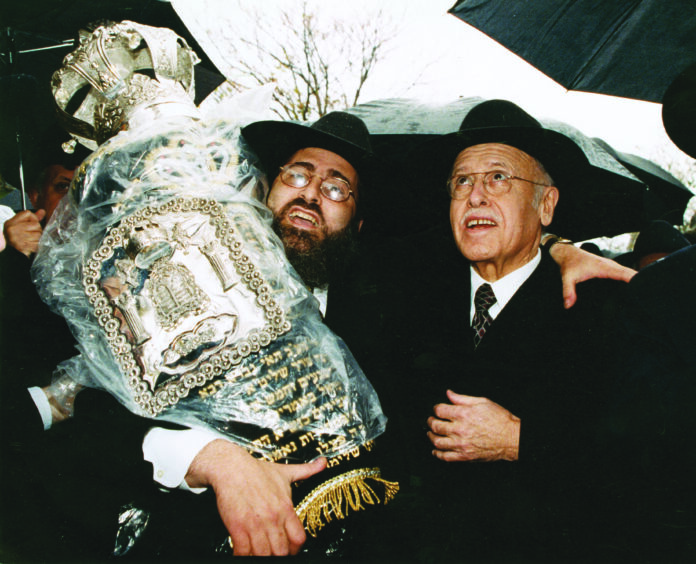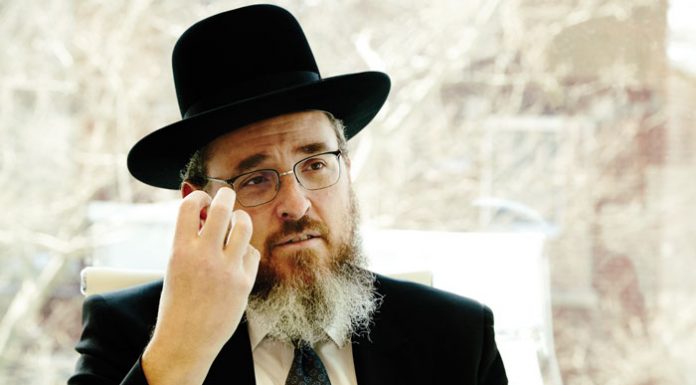The word askan, or community activist, can be flung around too often. The true heroes are those who utterly devote themselves to advocating on behalf of their fellow Jews, intervening at all levels of government in order to preserve the Torah way of life. Although there have been some disconcerting signs regarding the future of religious freedom in the United States, such as the ongoing court case with the New York Board of Regents and recent efforts by some politicians to ban metzitzah b’peh, Jews in America today live in a vastly better situation than did American Jews of the 1940s.
Much—if not most—of what has been achieved for the rights and quality of life of frum Jews in the United States since that time can be attributed to Rabbi Moshe Sherer, whose shtadlanus and askanus blazed the path for American Jewry. Even that which has been achieved in the 25 years since his passing was only attainable because of the foundations he laid and the relationships he forged. His work at Agudas Yisroel, first at the side of his cousin Reb Elimelech (Mike) Tress and then at the helm of the organization, built it up from a fledgling two-man operation to the lobbying powerhouse that it is today.
Many capable individuals have stepped up and tried to fill the void that Rabbi Sherer’s passing left in Jewish leadership. But his unique blend of hisbatlus to gedolei Yisrael, leadership ability, sensitivity, magnetic personality, powerful public speaking talent, emunah, and Torah knowledge are irreplaceable. It was this amalgamation of qualities that aided Rabbi Sherer when he adhered to every syllable of the gedolim’s instructions and worked successfully with politicians at all levels of government, from governors, congressmen and senators to prime ministers and presidents.
Now a generation has grown up without being able to witness his selfless public service that had not even a hint of self-interest. That is what the Mirrer rosh yeshivah, Rav Shmuel Berenbaum, worried about after Rabbi Sherer’s passing. At the shivah, he told Rav Shimshon Sherer, Rabbi Sherer’s son, “Es darf zain a buch—There needs to be a book about Rabbi Moshe Sherer. People think that to be an askan, you have to be a tumeler, a boisterous person. Rabbi Sherer showed that an askan should be anything but a tumeler.”
All that mattered to Rabbi Sherer was completing his missions from the gedolim, helping klal Yisrael, and returning home to his family. He never sought the spotlight, and the spotlight did not change him.
It is because of the need for today’s generation to learn about a role-model askan from close up that I am in the home of Rav Shimshon Sherer, standing in his study and trying to prevent him from falling off the ladder attached to his sefarim shrank. Rav Shimshon is reaching up for a set of bronze candlesticks. Though they do not seem particularly unique aesthetically, he proudly calls them “the most valuable items in my home.”
Rav Shimshon is an accomplished talmid chacham and popular speaker who has served as the rav of K’hal Zichron Mordechai in Flatbush for over 30 years. Growing up in his father’s home, he had a unique view into how a truly selfless askan conducts himself and his work, even away from the prying eyes of the public.
Early Inspiration
“These candlesticks have been in my family for generations, and they witnessed what was maybe the most lasting moment imprinted on my father’s mind,” Rav Shimshon tells me, referring to a well-known story from Rabbi Sherer’s childhood.
A few years before his passing in 1998, Rabbi Sherer spoke at a seudas hodaah after recovering from heart surgery. In his speech, he credited the tears of two women with inspiring him to undertake his life’s work as an askan. The first of these women was his mother, Mrs. Basya Sherer.
Mrs. Sherer came from a Stoliner home, and every time someone in the family had an ailment, she asked the Stoliner Rebbe for a brachah. Often, he instructed her to light another candle on Friday night, to the point where half the table was filled with small candles surrounding these bronze candlesticks. One Friday night, four-year-old Moshe Sherer hid underneath the table so that he could hear what his mother was davening for during this auspicious time.
“Although my grandfather was in the clothing business and the family was comfortable, when the Great Depression hit, they lost everything, and the children felt it,” Rav Shimshon says. “As soon as my grandmother was done lighting, her tears began to flow and my father caught a warm tear in the palm of his hand. He heard his mother murmur in a singsong voice, ‘Ribbono Shel Olam, balaichten zolstu di oigen fun maine kinderlach in dain heilige Torah—Light up my children’s eyes with Your holy Torah.’ He assumed that this was the first thing she was davening for, and that surely the next thing would be parnasah, but she repeated the same bakashah. Then she repeated it a third time, now sobbing and davening inaudibly.
“When he would repeat this story to me, he added, ‘All my mother cared about was the Torah. How could I devote my life to anything else? Even after she lost everything, all she cared about was that her children’s eyes would be lit up with the holy Torah.’
“The little plaque next to the leichters has an inscription by my father that he wrote in the elementary school yearbook of one of my sisters. So although these leichters may not be worth much on the open market, in our family they are invaluable.”
The inscription reads:
Our Family Heirloom—Bronze Candle-Sticks
There they stand so straight, strong, and erect; a pair of bronze candlesticks. You could actually call them “history books,” for they have witnessed more than any human eye could endure.
They first belonged to my great-grandmother. While in her possession, they witnessed all the persecution and wandering that she and her family had to live through in Russia. Finally, they were brought to America by my mother 70 years ago.
If only these candlesticks could talk, how many interesting tales they could relate! They were the center of my ancestors’ table during a period in history when the suffering of the Jews was unbearable under the Russian czars. In spite of all these troubles, my ancestors handed down these candlesticks from one daughter to another, and when the candles were lit in them on Friday night, these bronze candlesticks relit many memories of the past.
Today these candlesticks stand in the most prominent place in the breakfront of our dining room, always glittering and polished as if radiating happiness that so many years later, and so many thousands of miles away, they are still used on Friday nights with the same blessing recited over them.
These candlesticks are the symbol to me of the Jews’ strength and power to live eternally.
—Rabbi Moshe Sherer, June 1961
The second woman whose tears had a lifelong impact on Rabbi Sherer was Rebbetzin Chana Perel Kotler, the wife of Rav Aharon Kotler. In 1961, because Reb Elimelech Tress was very weak (he never recovered from his visit to the DP camps), more of the burden of Agudas Yisroel shifted to Rabbi Sherer. He began contemplating giving up his position there for numerous reasons, including the fact that it was a very difficult time in the Agudah and his income was sparse at best.
“The Agudah was in debt, and fundraising was increasingly difficult,” Rav Shimshon says. “Added to that was that Uncle Mike (Tress) was weak, suffering through his ailments. Because Uncle Mike was not well, my father had to shoulder some of his workload as well. The combination of all those factors led my father to decide to leave klal work.
To read more, subscribe to Ami





















